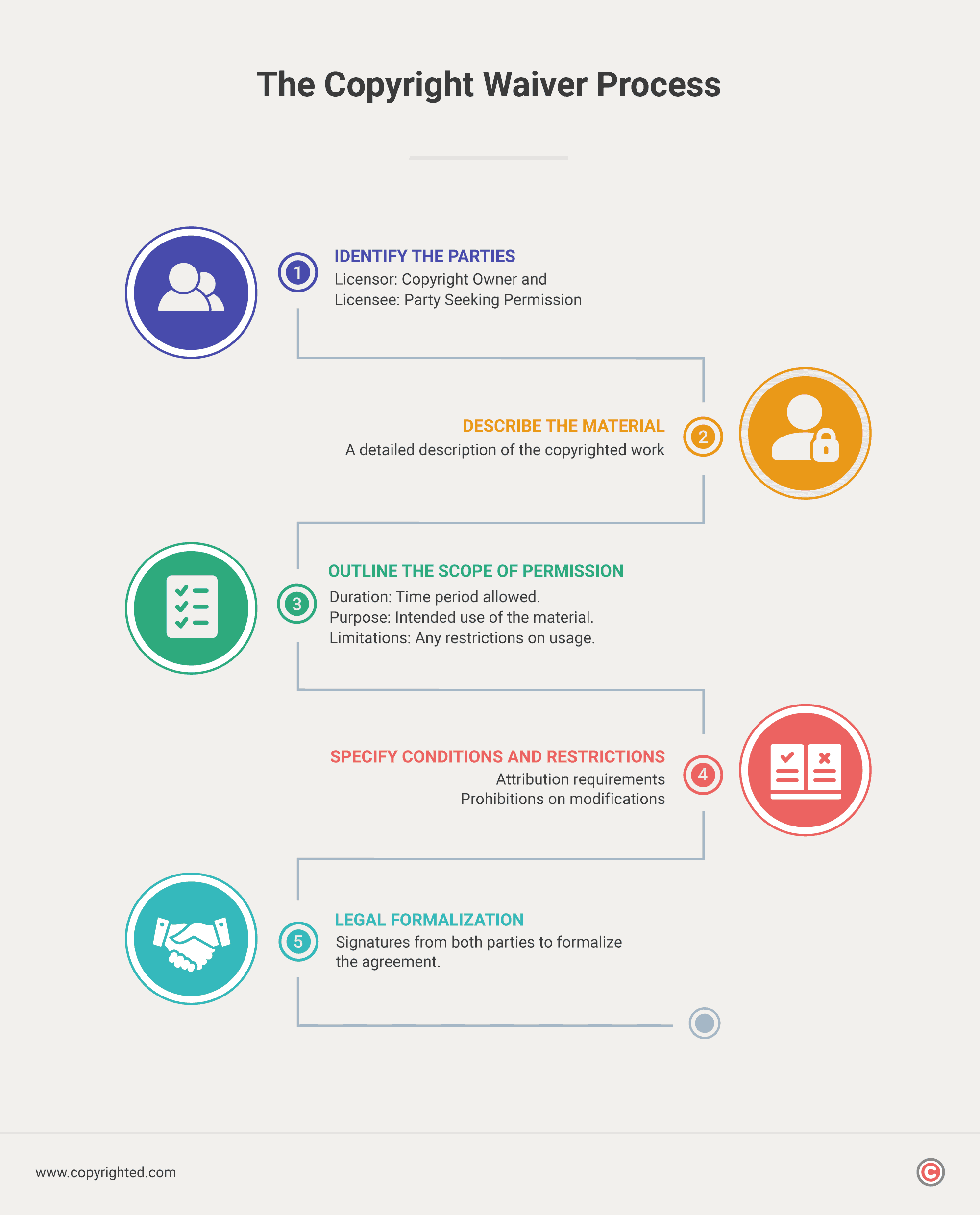In today’s digital era, protecting your work is more important than ever due to fast sharing and widespread connectivity.
Many creators struggle to ensure their work is used correctly and legally. Meanwhile, users of copyrighted works often struggle to understand permission complexities, unintentionally encountering possible legal issues.
In this context, strategically using Copyright Waivers stands out as a key solution.
This article will shed light on the topic of copyright waivers, exploring how they contribute to preventing copyright infringement. We’ll also talk about their advantages for creators and examine their limitations within the realm of copyright law.
- A copyright waiver outlines the allowed uses of a copyrighted work, providing clear authorization for actions like reproduction or distribution.
- A well-drafted waiver helps clarify the terms and conditions under which the copyrighted material can be used.
- Utilizing waivers for copyright infringement offers several benefits that can enhance the experience for creators and their audiences.
Table of Contents
How Does a Waiver Avoid Copyright Infringement From Happening?

A copyright infringement waiver is a legal document or agreement through which a copyright owner grants permission for the use, reproduction, distribution, or other specific actions related to their copyrighted work. This waiver allows others to use the copyrighted material in ways that would typically require the copyright owner’s permission, thereby providing a clear and documented authorization.
The terms and conditions of a copyright waiver can vary and are usually outlined in the agreement. They may specify the scope of use, any limitations or restrictions, whether attribution is required, and other relevant details.
A copyright waiver is a mechanism that allows the copyright owner to control how their work is utilized while providing a pathway for others to use it under agreed-upon terms. It is a means of managing permissions and encouraging the legal and authorized use of copyrighted content.
While a waiver alone does not automatically prevent copyright infringement, it plays a significant role in establishing a legal basis for the use of copyrighted content.
When someone seeks to use copyrighted material, obtaining a waiver demonstrates that the copyright holder has given explicit consent for the specified usage. This consent is important in situations where there might be ambiguity about whether the use constitutes fair use or falls under other exceptions to copyright law.
A well-drafted waiver helps clarify the terms and conditions under which the copyrighted material can be used, defining the scope of the permissions granted. These documents need to be specific, addressing all key elements to ensure clarity and prevent potential disputes.
Firstly, the identification of parties is essential in a waiver.
This involves specifying both the copyright owner, often referred to as the licensor, and the party seeking permission, known as the licensee. This step helps establish a clear understanding of who is granting and who is receiving permission.
A detailed description of the copyrighted material is another critical aspect of a well-structured waiver.
Providing a comprehensive and precise description helps avoid any confusion about the specific content covered by the waiver. This clarity is important to ensure that the parties involved have a mutual understanding of what is permitted under the agreement.
The scope of permission is also a fundamental element that outlines the exact ways in which the copyrighted material can be used.
This includes specifying the duration of the permission, the intended purpose, and any limitations on usage. Defining these parameters helps prevent misunderstandings and potential misuse of copyrighted content.
Conditions and restrictions further contribute to the specificity of a waiver.
These may include requirements such as attributing the copyright owner when using the material or limitations on making modifications to the content. Clearly outlining these conditions ensures that both parties are aware of any additional obligations or limitations associated with the granted permission.
Finally, signatures are essential to formalize the agreement.
The waiver should be signed by the copyright owner or an authorized representative, confirming their consent to the specified terms. The signature serves as a legal acknowledgment of the agreement and is important in establishing the validity and enforceability of the waiver.
What Kinds of Waivers are There for Creators?
Various types of waivers play a significant role in defining the boundaries of rights and responsibilities in the world of copyright. Let’s discuss three primary categories of waivers that have a substantial impact on creators:
Creative Commons
Creative Commons (CC) licenses provide creators with a standardized way to grant permissions to others regarding the use of their work. These licenses come in different forms, each specifying the extent of freedom granted to users.
For instance, some licenses allow commercial use, while others may require attribution. Creators can choose a CC license that aligns with their preferences, enabling them to share their work with a predefined set of permissions.
Public Domain
Public Domain dedications involve creators relinquishing all their copyright interests in a work, essentially placing it in the public domain. By doing so, creators allow anyone to use, modify, and distribute their work without any restrictions.
Public Domain dedications are a clear signal that the creator intends for their work to be freely available for public use, and they eliminate many of the traditional copyright limitations.
Custom Waivers and Agreements
Creators also have the flexibility to draft custom waivers and agreements based on their unique needs and preferences. These agreements can be customized to address specific conditions, limitations, or permissions that may not be covered by standardized licenses.
Custom agreements are particularly useful when creators want to negotiate terms individually with users or when they have specific requirements for the use of their work.
The choice of waiver or license significantly impacts how a creator’s work can be shared, reused, and attributed. While standardized licenses like Creative Commons offer simplicity and ease of use, custom agreements provide a more personalized approach.
In some legal discussions, particularly involving copyright infringement immunity, waivers and exceptions have been debated for their role in balancing creator rights and institutional protections, especially in complex cases involving state entities or public institutions.
Understanding these different types of waivers helps creators make informed decisions about how they want their creative works to be utilized within the bounds of copyright law.
What are the Benefits of Using a Waiver for Copyright Infringement?
Utilizing waivers for copyright infringement offers several benefits that can enhance the experience for creators and their audiences.
1. Promotes Creativity
Waivers contribute to a more creative environment by enabling creators to outline the terms under which their work can be utilized. This clarity creates a conducive environment for collaboration, as users can confidently engage with the content within the defined parameters.
By specifying the scope of permissions, creators can encourage the transformative use of their work, supporting the evolution and adaptation of ideas without the fear of unintentional infringement. This promotes a dynamic and innovative space where creativity can flourish.
2. Broadens Audience Reach
Waivers, especially those structured through platforms like Creative Commons, give way to a broader audience reach. By granting permissions for certain uses upfront, creators can attract a wider audience without compromising their copyright.
This accessibility can lead to increased visibility, exposure, and opportunities for collaboration or recognition. As a result, creators can benefit from a more extensive network of supporters, consumers, and fellow creators who appreciate and engage with their work within the specified terms.
What are the Limitations of a Waiver Against Copyright Infringement?
While waivers are valuable tools in managing permissions for copyrighted material, it’s essential to recognize their limitations and the boundaries they do not extend beyond.
- Non-Transferability of Waived Rights: Waivers generally apply only to the specific parties involved in the agreement and may not transfer to third parties without explicit consent. If someone not covered by the waiver uses the copyrighted material, the waiver does not provide protection.
- Limited Scope of Use: Waivers define the permissible uses of copyrighted material, and any usage outside the agreed-upon scope is not protected. If the waiver specifies certain conditions or restrictions, any violation of those terms may still constitute infringement.
- Geographical or Jurisdictional Limitations: Waivers may be subject to geographical or jurisdictional limitations, and the permissions granted might not be applicable globally. Infringement claims may arise if the copyrighted material is used in regions or jurisdictions not covered by the waiver.
- No Protection Against Future Infringement Claims: A waiver only addresses the permissions granted at the time of the agreement and does not shield against potential future claims of infringement. If circumstances change or the copyright owner’s perspective shifts, they may still pursue legal action for perceived violations.
When considering the limitations of waivers, it’s also important to note their impact on moral rights within international agreements such as the Berne Convention for the Protection of Literary and Artistic Works. Member nations are obligated to meet a minimum level of protection outlined in Article 6bis, but the convention does not explicitly regulate the waiver of moral rights.
Whether or not moral rights can be waived is not specified by the treaty, giving individual member nations the freedom to interpret and implement the Berne Convention in their own ways. This absence of universal guidance underscores the importance for creators and users to understand the specific legal landscape in each country.
Understanding these limitations is critical for both creators and users of copyrighted material. It emphasizes the importance of clear and comprehensive agreements, and in some cases, consulting legal professionals to ensure that the terms of the waiver align with the intended use and provide adequate protection within the confines of copyright law.
Frequently Asked Questions
How does a copyright waiver work?
A copyright waiver provides creators with clear authorization for actions like reproduction or distribution without the risk of copyright infringement.
What does a copyright waiver include?
It includes terms like the scope of use, limitations, attribution requirements, and other relevant details for authorized use.
Does a copyright waiver expire?
It depends on the agreement between the licensor and the licensee. The duration of a copyright waiver is typically outlined in the agreement and may be permanent or cover only a specified period.
Are there standard templates for copyright waivers?
While there are common elements, copyright waivers are often customized. Standardized templates may be available but should be adapted to specific needs.
Can a copyright waiver be used for any type of creative work?
Yes, a copyright waiver can be applied to various creative works, including literature, art, music, and more.


